From Vow On, Part 2
Last week, I started telling the story of Innistrad: Crimson Vow's design. This week I'll continue doing that. Last week was all about the Vampires, so this week I'll talk about the Zombies, Spirits, Werewolves, and Humans. Before I get to that, though, I want to let Adam Prosak (who co-led the set design for the set) introduce his Set Design team.
Click below to meet the Innistrad: Crimson Vow Set Design team.
Click here to meet the Set Design team
Adam Prosak (co-set lead)
That's me. As the set design lead, I'm responsible for managing all aspects of card design—I work with art directors, editors, and lots of other card designers, just to name a few groups that I work with. One of my primary responsibilities is to filter through the best ideas that other designers have. Fortunately, there were plenty of people who made this very easy for me. Previous sets that I've been the lead designer of include Modern Masters 2017, the original Modern Horizons, and Core Set 2021. For Innistrad: Crimson Vow, the Set Design team went through multiple iterations.
Erik Lauer (co-set lead)
Erik was the set design lead for the first few months of Innistrad: Crimson Vow. Erik is one of our most talented designers, and I felt confident in the set from the start. Over my years as a Wizard, I've learned a ton from Erik, and I don't expect that trend to stop. I consider Erik both a master tactician as well as a great mentor.
Ethan Fleischer
Ethan is an experienced designer that worked on Innistrad: Crimson Vow before I took over as the set design lead. Among many other things, Ethan is responsible for keeping our planeswalkers in order, helping define the mechanical space that each of our planeswalkers characters should have.
Ken Nagle
Ken is another experienced designer who worked on Innistrad: Crimson Vow early in the process. Ken is well known for being an out-of-the-box designer, generally coming up with ideas that other designers haven't thought about.
Ari Nieh
The most recent Great Designer Search winner, Ari is an exceptional designer who was the person in charge of the white color pie. As a result, Ari constantly pushed for new space with our white designs. I hope that Innistrad: Crimson Vow shows off Ari's excellent work with regards to novel white cards.
Reggie Valk
My favorite thing about Reggie is how often he plays niche cards and decks in competitive Constructed environments. Many of our meetings started with one of his latest exploits, which I always enjoyed. As for Innistrad: Crimson Vow, Reggie's primary role was to provide some consistency between Innistrad: Midnight Hunt and Innistrad: Crimson Vow. We wanted the two sets to feel connected but distinct. Reggie was instrumental in making that happen.
Chris Mooney
Chris was one of my favorite people to work with on Innistrad: Crimson Vow. Chris really enjoyed designing cards to fit our Vampire wedding theme, and many of their designs endured long after Chris left the team. When someone asked me, "Who came up with the idea for this card?" the answer was usually Chris.
Corey Bowen
Like Chris, Corey also focused on the early portion of set design. I always appreciate Corey's ability to come up with charming designs, as well as truly novel cards. Corey's career goal is to get a card printed with the name "Quarry Bowman."
Michael Hinderaker
Other than myself, Michael was the longest tenured member of the Set Design team. Michael and I would have constant conversations about the set, and I always appreciated his valuable insight in guiding the set from start to finish. Michael mostly focuses on play design, but I was happy he was able to get a chance to work on most of the set design process.
Megan Smith
While Megan works primarily on other projects, I was very grateful to get her perspective on Magic. She was excellent at designing new cards and giving feedback on existing cards, both of which are valuable late in the process.
Patrick Sullivan
We were very fortunate to contract Patrick Sullivan to join the Innistrad: Crimson Vow team. The long-time commentator and content creator is well known for his game design prowess, and I was very happy to have him share some of his knowledge. He was excellent at helping guide what types of cards to make, and he really homed in on the cards that would make for fun gameplay.
Andrew Brown
Last and certainly not least, Andrew had many notable roles when it comes to Innistrad: Crimson Vow. His primary responsibly is that of play design technical lead, but Andrew also works tirelessly to make sure each set has enough content for Standard well before the rest of the Play Design team focuses on that set. Moreover, Andrew also puts a ton of focus on Booster Draft.
Zombies
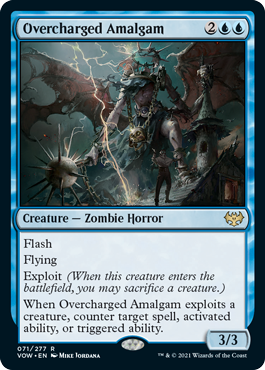
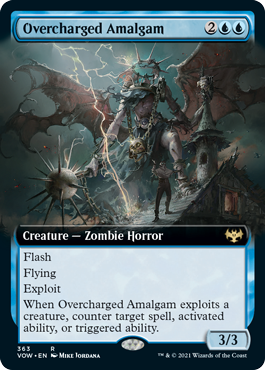
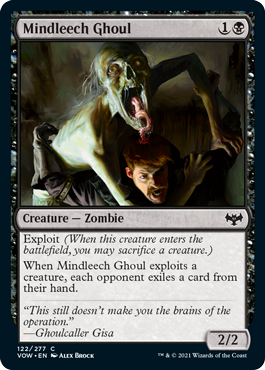
I mentioned last week that we spent a whole meeting brainstorming Zombie ideas while figuring out whether to focus the set on Vampires or Zombies. Our original Zombie mechanic came out of this brainstorm. We were exploring how to make a Zombie horde that didn't just gum up the board and ended up making decayed. (I told the longer version of this story in one of my Innistrad: Midnight Hunt preview columns.)
Since then, I've learned a little more about it. It turns out the other trading card game Wizards R&D currently makes, called Duel Master (it's a TCG we make for the Japanese market), has an unnamed mechanic that gets used in most sets called "crunchy." A creature with crunchy is destroyed after it attacks or blocks and deals damage. Our first exploration into making decayed was simply a creature token that couldn't block. That wasn't substantial enough, so I was asking for other things we could add to the tokens, and someone from the team, Andrew Veen, suggested that it died after it dealt combat damage. He has designed a bunch of Duel Masters sets and was aware that crunchy played well. This is a great example of why having cross pollination of designers between games (assuming you're at a game company that makes more than one game) can be a valuable tool. It wasn't until Andrew and I were recently talking that I even realized the Duel Masters connection.
This, of course, leads me to the next question—how did decayed end up in Innistrad: Midnight Hunt? I believe we have Erik Lauer to thank for that. As the person in charge of set design, it's very common for Erik to start a Set Design team and then hand it off to another designer. Erik, for example, took the handoff from Vision Design for both Innistrad: Midnight Hunt and Innistrad: Crimson Vow. He realized that there were two mechanics that would be more synergistic if they were swapped, so he moved decayed to Innistrad: Midnight Hunt and then moved disturb to Innistrad: Crimson Vow. But wait, wasn't disturb in Innistrad: Midnight Hunt? It was. We'll get there when I talk about the Spirits.
When Erik handed off the set to Adam Prosak, the Zombies didn't have a mechanic because decayed had just moved to Innistrad: Midnight Hunt. That meant it was up to Adam and his Set Design team to find something.
The biggest difference between the Zombies of Innistrad: Midnight Hunt and the Zombies of Innistrad: Crimson Vow was a creative one. During the first Innistrad, when we were trying to find a second color for the Zombies, it dawned on us that gothic horror had two different takes on Zombies. The first was the result of necromancy, of magic. The second, however, was more about science. Frankenstein's monster, for example, was a Zombie constructed rather than raised. For original Innistrad, we used the difference to separate the colors. Black Zombies were the creation of necromancy, while blue ones were the creation of science. We called them Skaabs.
To differentiate between Innistrad: Midnight Hunt and Innistrad: Crimson Vow, the Creative team leaned more on the necromantic Zombies for the first set and more on the Skaabs for the second set. This, for example, is why Gisa shows up in Innistrad: Midnight Hunt and Geralf shows up in Innistrad: Crimson Vow (the sister and brother have very different views on the best way to make a Zombie). All of this meant that the Zombies in Innistrad: Crimson Vow were more focused in wanting to get cards into the graveyard and using them out of the graveyard. In contrast, the Zombies in Innistrad: Midnight Hunt were more about acquiring a giant army of 2/2 Zombies. Therefore, decayed made more sense there.
When the set was handed off from Erik to Adam, it didn't have a mechanic for the Zombies, but it played more into the Skaab territory, that is, Zombies that used the graveyard as a resource. This differentiated Zombies in Innistrad: Crimson Vow from Innistrad: Midnight Hunt and played synergistically with Blood tokens. Adam and his Set Design team were interested in finding a mechanic that further helped Zombies synergize with graveyards.
They explored a bunch of new mechanics but realized what they needed already existed in the mechanic exploit. Exploit had been the faction mechanic for the Silumgar (blue-black) clan in Dragons of Tarkir and allowed a player to sacrifice a creature to create an "enters the battlefield" effect. This allowed some of the Zombies in the set to have extra utility while interacting with the Zombies, and other aspects of the set, that cared about the graveyard as a resource.
Spirits
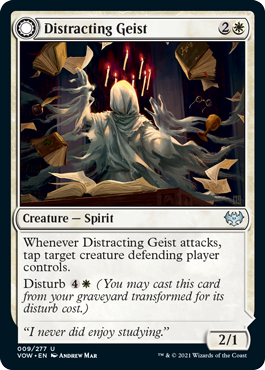
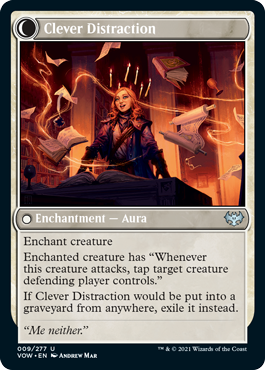
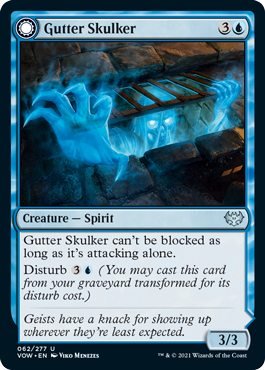

One of the goals of the Innistrad: Midnight Hunt Vision Design team was to find a flavorful mechanic for Spirits. Early on, we acknowledged that we loved the flavor of haunt but didn't like the mechanical execution. Was there a different way to capture the idea of a creature dying and then inhabiting a living creature?
As we brainstormed solutions, we realized we had a very handy tool at our disposal—transforming double-faced cards (TDFC). We could make the front side a Spirit and make the backside an Aura that granted the enchanted creature the same ability as the Spirit. In our original version, when the creature died, it just turned into the Aura and was attached to a creature of your choice. There wasn't any mana involved. We were very happy with that mechanic and expected it to be in Innistrad: Midnight Hunt.
When the mechanic got to Innistrad: Midnight Hunt set design, they decided to add a mana cost to "cast" the Aura. Because the Innistrad sets were using TDFCs, the cost for the effect was put on the front side of the card, as that is what would be face up and active in the graveyard. As the Set Design team played around with the cards, they realized that there was a similar execution that used a creature on both sides. The front could be a non-Spirit, and the backside could be a Spirit. When looking at that version and the Aura version, it made sense to do the creature version first and the Aura version second. So, when decayed got moved from Innistrad: Crimson Vow to Innistrad: Midnight Hunt, the Aura version of disturb got moved from Innistrad: Midnight Hunt to Innistrad: Crimson Vow.
Werewolves
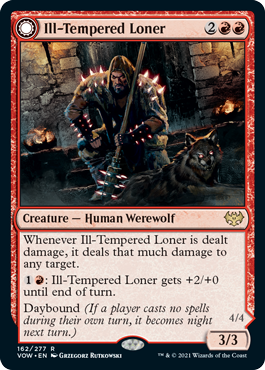
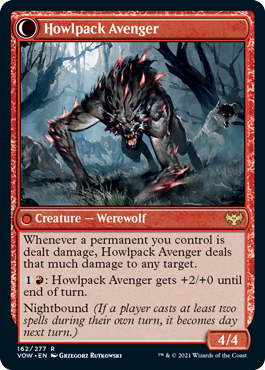
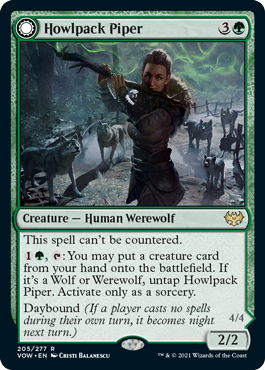
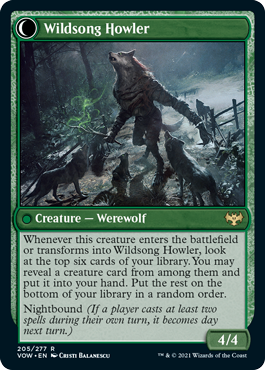
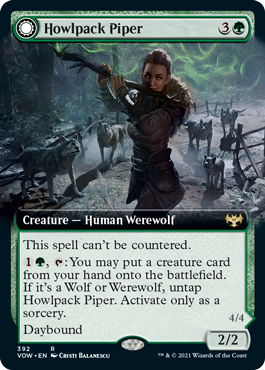
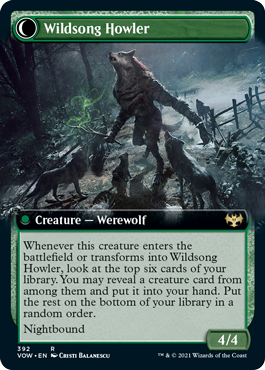
We did talk about whether Werewolves were supposed to have a different mechanic between Innistrad: Midnight Hunt and Innistrad: Crimson Vow, but it became clear pretty quickly that playing daybound/nightbound Werewolves in Standard with ones without daybound/nightbound would be logistically problematic. For example, we couldn't just retreat to the old "Werewolf mechanic" (what we did in old Innistrad sets), as that would confuse players because it was so close to daybound/nightbound but not quite the same.
It would require something completely different, and that was leading to a path of chaos and bad flavor.
In the end, we decided to keep daybound/nightbound for the Werewolves without using it anywhere else in the set, as that was Innistrad: Midnight Hunt's main thing. This means the Werewolves are the only focused creature type in Innistrad: Crimson Vow not to get a new thing, although because their front was Human, they would interact a little bit with what the Humans were up to.
Humans
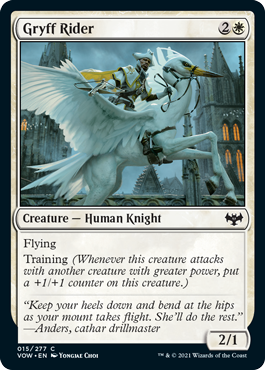
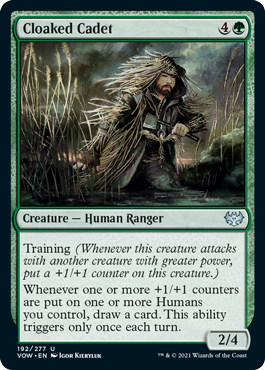
Speaking of the Humans, they've always been the one non-monster creature type in Innistrad sets to get tribal support. The flavor we usually use concerns Humans banding together, as their existence is all about surviving the many creatures out to kill them. Innistrad: Midnight Hunt leaned into the Humans use of witchcraft for protection. Innistrad: Crimson Vow's goal was to pull them back to the center. The mechanic we ended up going with was originally called student (printed as training), and it was inspired by the mentor mechanic from Guilds of Ravnica.
The Vision Design team handed it off as the Boros mechanic (being the police/army guild, we liked the idea that they worked together to improve one another), and Erik Lauer kept it in the set when he took over as the lead set designer. The more he played with it, though, the more he realized it was backwards. If you had a larger creature, you cared more about hitting with that than you did about making your smaller creature bigger. Erik suggested we used "fixed mentor" as the mechanic for Humans in Innistrad: Crimson Vow. This way, the creatures got to work together, but the creature with the mechanic had the ability to make itself bigger. It also worked interestingly with Werewolves because you could first train with the Human side and train later with the larger Werewolf side.
Cleave It to Beaver
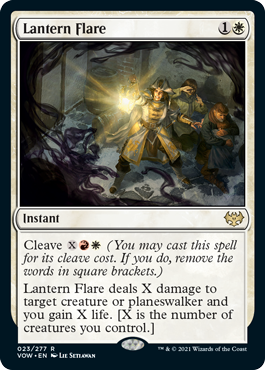
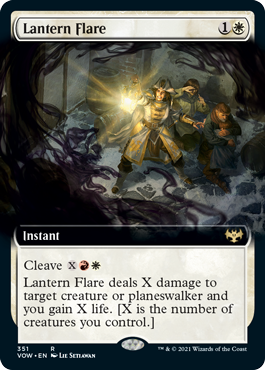
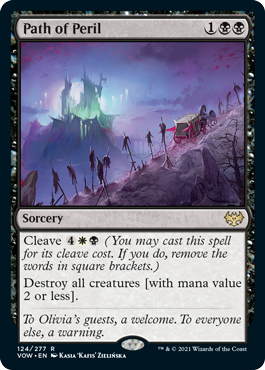
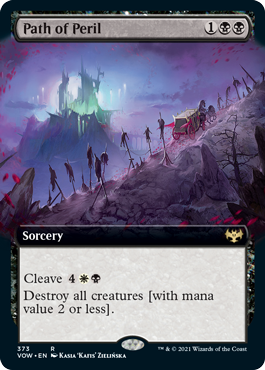
Once the Set Design team was done figuring out what each of the five main creature types was up to, Adam realized they had a problem. Exploit, disturb, daybound/nightbound, and training all went on creature spells. Instant and sorceries could create Blood tokens, but it was the Vampires that were going to most efficiently be using that Blood. What the set really needed was a mechanic that could be focused on instants and sorceries.
Also, the set needed what R&D calls a "mana sink," which is some mechanical means to use extra mana. Adam realized that he probably wanted to tackle both problems with a single mechanic. Erik Lauer had turned over the file with the multikicker mechanic (from Worldwake, a kicker variant that you can use as many times as you wish) to solve these two problems, but multikicker felt like an odd fit in Innistrad. Adam did think about reusing flashback, as Innistrad: Midnight Hunt had used it, but in the end, he decided to go with a new mechanic instead.
That new mechanic had an interesting origin. In exploratory design for Streets of New Capenna (codenamed "Ice Skating"), Ari Nieh had come up with a novel new mechanic. She was trying to capture a sense of crime and stumbled upon a mechanic where players could pay extra mana to remove rules text from a card. The Exploratory team does what we normally do when we come across a cool new mechanic, marking it as something for the Vision Design team to consider and moving on to making other mechanics.
When Streets of New Capenna was in vision design, the team was looking for a mechanic to fit a certain flavor, and Ari brought the mechanic back up for consideration. Mark Gottlieb, the vision design lead of Streets of New Capenna, didn't think it was the right fit but acknowledged that he liked the mechanic. A month or two later, while in a set design meeting for Innistrad: Crimson Vow, Gottlieb suggested this new mechanic for the hole Adam was looking to fill, and that is how cleave made it into the set.
Before moving on, I do want to say a quick word about the challenge of designing cleave cards. The core conceit of the mechanic is that it has rules text that constrains the effect in some way, and by paying the cleave cost, you get to remove that restriction. I'm not sure how easy that sounds to design, but it's actually very hard to do. The Innistrad: Crimson Vow design team spent a lot of time trying to find the right mix of restrictions that played well when you couldn't pay the cleave cost. This is another reason cleave was a good fit for the set. It's the kind of mechanic that has a much smaller design space than it might seem at first glance, and it wanted a set where it didn't need to be on a whole bunch of cards. Innistrad: Crimson Vow's needs ended up aligning perfectly with cleave's limitations.
Monster Mash
And that, in three thousand or so words, is how all the non-Vampires came to get designed in Innistrad: Crimson Vow. I'm excited for you all to get to play with the set, as there are a lot of inherent synergies between all the mechanics I talked about today that will come out when you play the set. As always, I'm eager for any feedback, either on the article, any of the mechanics I talked about, or on Innistrad: Crimson Vow as a whole. You can email me or contact me through any of my social media accounts (Twitter, Tumblr, Instagram, and TikTok).
Join me next week as I start telling my card-by-card stories about cards from the set.
Until then, may you enjoy surviving the world of Innistrad in Innistrad: Crimson Vow.
#883: Khans of Tarkir with Erik Lauer
#883: Khans of Tarkir with Erik Lauer
I sit down with Designer Erik Lauer, and we talk about the design of Khans of Tarkir.
#884: Color Pie Changes 2021, Part 2
#884: Color Pie Changes 2021, Part 2
This is part two of a two-part series where I go over the various changes to the color pie as outlined in the 2021 Mechanical Color Pie article.
- Episode 882 Color Pie Changes 2021, Part 1
- Episode 881 Strixhaven with Yoni Skolnik
- Episode 880 Cards Starting with X

